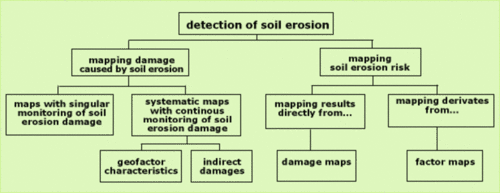Approaches detecting soil erosion
Soil erosion processes have become a focus of several disciplines due to their influences on the natural resources of a region and the consequences involved for quality of (human) life. Various methods to detect soil erosion damages by water has been developed. These can be basically differentiated into two approaches (see figure):
- Qualitative approaches: focus on a qualitative assessment of damages and their occurrence dependent on several landscape factors. It includes mapping of soil erosion damages which appear in consequence of heavy rainfall. These approaches were in the centre of attention in the beginning of soil erosion research.
- Quantitative approaches: these approaches were developed to the necessity to balance erosional processes and with the improving computer capabilities. Qualitative approaches use surveys about complete acquisition of the soil loss data in a defined area as a base for the assessment of soil erosion risks and factors influencing soil erosion risk. A multiply of tools are available; Universal Soil Loss Equation (USLE; Wischmeier & Smith 1962, 1978) or the European Soil Erosion Model (EUROSEM; Morgan et al. 1991) are examples. Their adaptability on a large scale range is restricted (Beck et al. 2004; Schütt and Tiemann 2001).



